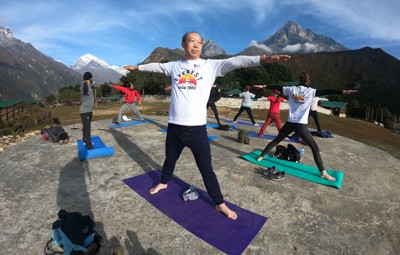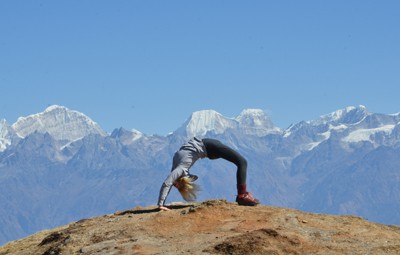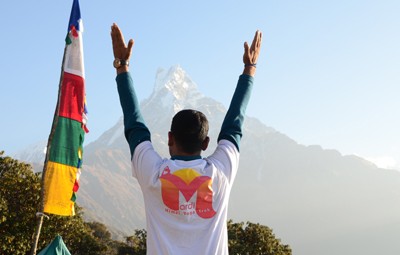When you arrive in Nepal, it just seems that there is a distinct air of spirituality that abounds in the air. It is, after all, the land of gods and goddesses. Travelers describe Kathmandu, Bhaktapur, and Patan as the towns of temples and goddesses. There seem to be more gods than humans here, Despite modernization creeping into these places and concrete jungles sprouting up in sprawly patches all over these cities, they are still dominated by ancient temple structures that inspire faith in anyone lucky enough to walk their premises.
Nepal is not only connected with Hinduism, but it is also the land of Lord Gautama Buddha and is a major Buddhist destination for practicing devotees. Nepal has a long history of Buddhism, which can still be witnessed in Upper Mustang.
In Mustang, there is a statue of Padmasambhava. After visiting Nepal and India, he returned to Tibet to spread Buddhism. He wanted to build a monastery, but he didn't get permission, so he went back to Mustang and built his own statue.
Pharping Monastery, near Kathmandu Valley, is a sacred place for Hindus and Buddhists alike. It is here that we can see the cave where Guru Rinpoche meditated. The fact that Hindus worshiped at Buddhist temples and Buddhists did the same at Hindu temples has been one of the principal reasons why adherents of these two dominant religious groups in Nepal have never come to blows in their spiritual practice.
Why Yoga Trek in Nepal?
It's well known that yogis have practiced all sutras and meditation in the Himalayas. God lives in the Himalayas!
Shiva, Yoga, Himalayas!
In the yogic culture, Shiva is revered as the first guru, or Adi Guru. He is also known as the Adi Yogi, or the first Yogi. He was said to, become ecstatic, dancing all over the mountains, or he would sit absolutely still during a state of enlightenment. During his mad bouts of dancing, all the other gods were envious because he was having such an amazing time on the earthly plane. Suddenly, the gods realized, Heaven wasn't such a cool place after all and that they were missing out, so they decided to get Shiva to let them in on his secret. When they finally got him to teach them his methods, Shiva expounded on various types of yogas movements depending upon the level of preparedness of the person who was sitting in front of him.
Spiritual ethos means that no matter who you are or where you come from, liberation is the ultimate goal for everybody. Even today, even the simplest farmer in this country will talk about Mukti. This is a result of the phenomenal amount of spiritual work done in this country. One person who is largely responsible for this, who is of paramount significance in shaping the human consciousness in Shiva.
The first part of Shiva's teaching was given to Parvati, his wife, and his consort. It was taught in a certain intimacy. In - very gentle and detailed ways, Shiva expounded his yogic methods to Parvathi. The yoga sutras of Shiva are such that almost in every sutra, he refers to her as the resplendent one or the gracious one. This teaching transpired between them both with the utmost intimacy. Intimacy should not be understood as simply meaning sexuality. It just means that there is no resistance; this person is absolutely open to whatever is being offered.
The second set of yogic teachings was expounded to the Sapta Rishis, or the first seven Sages. When using the word yoga, you should not think of twisting your body, holding your breath, or anything like that, as we are not referring to a particular exercise or a technique. We are talking about the very science of creation and how to take this creation (you) to its ultimate possibility. We are looking at gaining mastery over the fundamental processes of life; the very processes of creation and dissolution. It doesn't matter at what level of evolution a person is right now. For every being on the planet, there is a unique way of achieving that mastery.
Best Yoga Treks in Nepal
Today, yoga is said to be the world's fastest-growing wellness regimen because it incorporates a sense of spirituality in today's fast-paced modern world. Yoga is not only an elaborate system of physical exercises; it is a spiritual discipline, purporting to lead the soul to Samadhi, which is the total union of oneself with the divine being.
The 8 Staircases of Yoga are: self-control (yama), religious observance (niyama), postures (asana), breathing exercises (pranayama), sense control (pratyahara), concentration (dharana), deep contemplation (dhyana), and finally, enlightenment (samadhi).
Yoga is primarily a spiritual discipline. Even priests and nuns in the seminaries and novitiates promote yoga to supplement their daily meditation and prayer. Philosophy and practice are inseparable!
Mahashivratri is a festival that was chosen to honor Shiva, the Adi guru, from whom yoga originated. On this night, the planetary positions in the northern hemisphere are such that there is a natural upsurge of energies. If one just stays awake and keeps one's spine erect throughout the night, it naturally pushes a person toward his spiritual peak.



